Fig 4. LFP recorded near layer 4 drives optimal state classifier performance.
A. We constructed two sets of state classifiers: first, using the power ratio and activation from single channels across the array (black label, top) and second, by adding to the best single-channel classifier a third predictor, the activation from a secondary channel (green label, bottom). B. Spatial profile of fVE for classifiers using as input each channel of the array. Black, solid: input was single channel LFP. Vertical axis indicates the depth of the input channel. Green, dash: inputs were taken from pairs of channels, one of which is the channel at y = 0. Vertical axis indicates the depth of the second input channel. Shaded regions show ± 1 SEM estimated from bootstrapped fVE calculation. C. Normalized fVE spatial profile averaged across recordings, with fVE normalized by the maximum fVE on each single recording. Recordings were aligned based on assigned L4 channels and then averaged. Each point is an average over N = 9 recordings with > 500 μm of overlap after alignment. Shaded region shows ± 1 SEM across recordings. D. Performance of classifiers using pairs of channels vs. the best single-channel classifier for N = 11 recordings. Estimated error bars (from bootstrap) are approximately ± 0.02 and omitted for clarity. No significant difference between single-channel vs. pair-channel classifiers for any recording.

